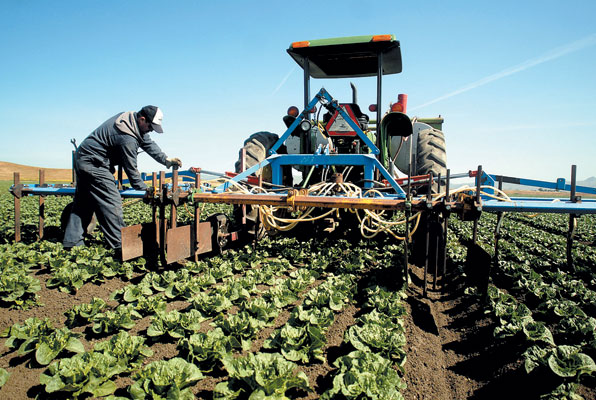
While rising gas prices ripple across the economy, they recently
have plowed through an increasing slice of local farmers’ profits
and could ultimately result in fewer crops being grown and higher
prices at the supermarket for consumers.
While rising gas prices ripple across the economy, they recently have plowed through an increasing slice of local farmers’ profits and could ultimately result in fewer crops being grown and higher prices at the supermarket for consumers.
Some fertilizers have jumped by 60 percent in the last year, said Mark Wright, general manager at Filice Farms in San Benito County. Wright noted in particular that nitrogen fertilizer’s demand has gone up globally and how natural gas is used in the process to manufacture it. Filice Farms uses 10 fertilizers – all nitrogen based – on its property that grows products for 11 different companies.
Figuring out final costs for some of those businesses probably will have to wait until the end of the year because those numbers can’t be set without knowing expenses for such relatively expensive necessities as fertilizers. As gas prices go, though, so do the costs of fertilizer, Wright pointed out.
County Agriculture Commissioner Paul Matulich also attributed the fertilizer spike to rising transportation costs due to gas prices. He noted how it’s costing truckers around $1,000 just to fill up their tankers.
“(The) market is paying for higher (prices) of fertilizer,” Matulich said.
With so much produce in California and many of the fruits and vegetables grown here sold at market rate – as opposed to most dairy products – it means consumers will eventually pay extra when those costs are added to the prices of such food. Some farmers also historically grow fewer crops when fertilizer prices increase, which also could affect demand.
“(It) takes energy to produce fertilizer,” said local vegetable grower Richard Bianchi.
While fertilizer prices have soared, urea – an organic compound fertilizer used for plants with the highest proportion of nitrogen at 46 percent – is selling for nearly $550 a ton, according to the Delta Farm Press Web site. A year ago it was around $400.
Bianchi said there isn’t much nitrogen produced in the United States and none is produced in California, while most fertilizer comes from China.
“(Prices are) going to continue to go up,” he said.
It’s difficult, however, to find one set price for fertilizer since there are more than 100 types and each varies based on its use and what type of crop is being grown, Bianchi said. He added that in the past 10 to 12 months, the price has jumped by about 30 percent, and in the last 18 months, it has increased by 70 percent.
And he said consumers will end up paying the price.









